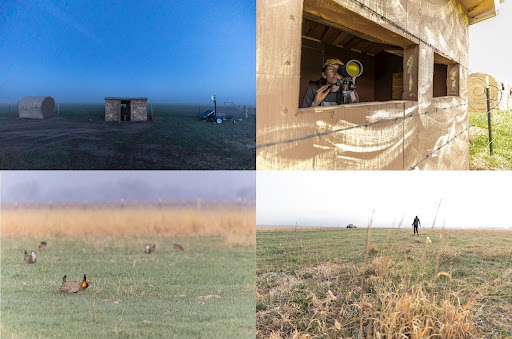Starting in mid-January, the Crane Trust science team surveys our greater prairie chickens’ (Tympanuchus cupido pinnatus) lekking behavior on Mormon Island. To complete a survey, we have to meet at our headquarters while it is still dark, drive to Mormon Island, walk to the blinds, and wait for the sun to rise. Once settled into the blind we wait for the lek to come alive.
Lekking Behavior
Eventually, individuals fly in and begin to engage with one another. Males raise their pinnae and tails, put their heads down to inflate their colorful air sacs and stomp. Stomping around 20 times per second and then using their air sacs to boom, showing off to the ladies and showing other males who’s boss. Dominant males will chase off less dominant males and spar when they are equally dominant—running, jumping, scratching, and flapping at one another in a violent dance for the persistence of their genes. The most dominant males will reside in the center of the lek, breeding 90% of the females.
The Survey
As the greater prairie chickens put on a show, we observe and record their behavior every three minutes for at least 30 minutes.
We look for 10 different behaviors:
- Booming- Deep three-syllable call produced as esophageal air sacs inflate and deflate.
- Strutting- The male bends forward positioning their body parallel to the ground with wings to the side and performing a rapid quick step.
- Flutter Jumps- Leaps into the air while flapping wings, often producing whoop, cackle, or whine calls, to display position in lek.
- Nuptial Bow- Male spreads wings and lowers bill to the ground with pinnae in erect position; often precedes copulation.
- Sparring- Dominance displays through charging and fighting.
- Copulation- Male mounts female.
- Foraging- Includes movement foraging (walking, scanning, and occasionally pecking at the ground).
- Loafing- Includes preening and resting.
- Flying- No explanation needed.
- Predator avoidance- How the prairie chicken responded to a predation attempt- flushing, crouching, fighting back, or walking away from potential predators.
While recording behavior we also identify the sex of individuals since greater female presence indicates successful population establishment. (Females have shorter pinnae and less prominent eye combs.) We also take special note of any predator interactions as we go, recording the predator species, hunting method, and the time of the attack. Recording this ensures monitoring of the development of this new population (established in 2015), the environmental conditions they need to organize lekking behavior, and how weather affects male lekking behavior. We also want to document the interactions with other grassland birds.
Lekking Aftermath
From early spring to the beginning of June, females will lay 7-17 eggs. These eggs are olive with dark brown spots and brood for 23-26 days before chicks hatch. Hatching success is high (73-93%), but nest success is lower (22-65%) due to predation and nest destruction. Females raise young alone, building nests out of vegetation in depressions covered by native warm-season grasses. These grasses include little bluestem, big bluestem, switchgrass, Indiangrass, and more. Some non-native cool-season grasses, like smooth brome, can attract nesting females. The problem with these non-native grasses is that if they take over and create a monoculture on the landscape they could reduce habitat quality and lower their chick’s chances of survival. The ideal nesting and chick-rearing habitat is medium-height, dense grasses to provide shade and protection from predators. Prairie chickens need dense grasses, but they cannot be so dense that incoming predators are imperceivable or hinder their chicks’ ability to escape. Once chicks have developed enough to leave the nest, sparser vegetation is required. Recently disturbed areas, with forb cover, are perfect areas for young chickens to catch insects and grow. Chicks are precocial, which means they can walk and catch food shortly after hatching. Remarkably, they can even fly within 1-2 weeks. Due to their fast development chicks only stay with mom for 8-10 weeks, then disperse and intermix with other juveniles.
Challenges and Concerns
Our small population is doing well on Mormon Island’s prairie, but that is not always the case. Due to the increasing conversion of prairie to farmland and urban sprawl in the early 1900s, prairie chicken habitat has become severely fragmented in most areas. They need at least 185 acres of connected prairie in different levels of succession to maintain a successful breeding population. Our secure remaining populations are in north-central Nebraska, south-central South Dakota, and eastern Kansas. In seven different states, there are small, remnant, and reintroduced populations. These populations are isolated and at risk of inbreeding and collapse. Work done to protect, maintain, and restore prairie will help protect these at-risk populations.
What We Do
By managing the landscape with multiple methods (grazing, resting, mowing/shredding, disking, burning), conducting scientific research, and providing education we protect and maintain the physical, hydrological and biological integrity of the Big Bend area of the Platte River. Providing the needed habitat heterogeneity, monitoring their population, and sharing their story with you enables us and the larger conservation community to maintain healthier greater prairie chicken populations.
Greater Prairie Chicken Virtual Program
Want to learn and see more? Crane Trust Members can see the Lek in action. Simply log into the Membership Portal and tune in to our Virtual Camera every morning through the beginning of May, from 6:30 AM – 10 AM and every evening from 7 PM – 9 PM. We will also offer 5 Guided Virtual Lek Tours, morning and evening on April 23, 25, 27, 30, and May 2nd. May 2nd’s tour is open to the public for Go Big Give!

